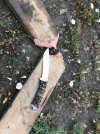
I'm sure this has been covered quite a bit, but I was curious if there is a somewhat excepted process for testing the quality of a blade.
I know about the js test, but my understanding is that the test is designed to tell what a smith is capable of, not necessarily what would make a quaility blade.
This is the fifth knife I've made, and the first of this size. It was my attempt at a camp kife, but I forged it too close to the final size, so there are several flaws in it. It seemed like a good opportunity to test my HT on 1084.
Here's what I did after I forged the general shape and roughed in the grind.
1. I HT in my garage with the lights off so I can be as cosistent as possible.
2. I brought it a couple shades past magnetic for 5 mins then air cooled.
4. Just past magnetic for 5 mins then air cooled.
5. Just under magnetic for 5 mins then air cooled.
6. One shade past magnetice and quenched in 125 degree canola oil.
7. Placed it in pre heated oven (verified at 400 degrees) between two fire bricks. They turned a cosistent straw color, but slightly darker than straw.
The test I did consisted of the following.
1. 30 degree edge shaving sharp. Rolled it on brass rod both directions. No chipping.
2. 250 hits into an old fir 8x8. (cut about 4" into it)
3. slice a 1/2" nylon rope 100 times.
4. chop a 2x6 in half.
5. Throw it through 1/2 plywood a couple dozen time. (I'm not good at that, most ended up bouncing around in the gravel)
6. chop 1/8" brass rod 25 times.
7. I put it in the vise mid blade and applied 100 lbs of sideway force to the top of the handle. It does bend a bit, but springs right back.
9. I took an extra piece off of the same bar a put through the same process at the same time so I could bend test it without ruining my knife. It cracked slightly at about 50 degrees, and was broke in half at 90 degrees. I put it in a vise and bent it by hitting it with a hammer, it might have done better if I had a piece of pipe to bend it with.
It is still pretty sharp, not jumping hair of my arm the way it was, but will still slice paper just fine, and still cuts right through the nylon rope. I did my best to keep all the chopping and cutting to the middle 3" of the blade and tested the sharpness there.
Aside from some slight dings from the gravel, there is no real damage to the edge.
Does this seem like a good torture test, or was I too easy on it?
Any input would be appreciated.
I'm pretty happy with the results, but don't really know if I should be.
Thanks.
